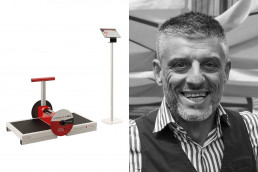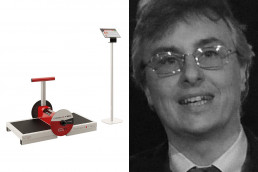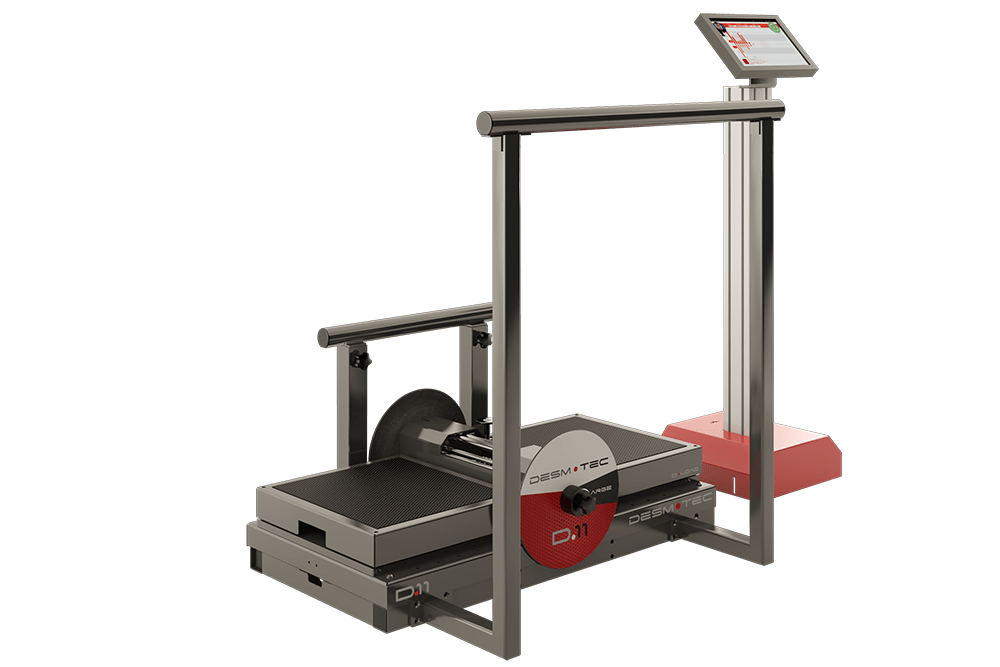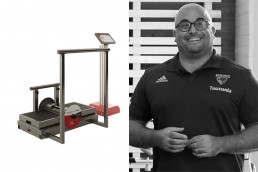Эксцентрическая сила и возвращение в спорт после реконструкции крестообразных связок
Scientific study for Physiotherapists
It was presented at the «XXII International Congress of Sport Rehabilitation and Traumatology», in Milan Italy.
The study was published by Sebastiano Zuppardo, Physiotherapist, knee specialist and Desmotec Academy member.
The aim of this project was to assess the eccentric strenght deficit during the last rehabilitation phase after ACL reconstruction and the recovery of such deficit after resuming agonistic sport activity. The device DESMOTEC D.SPORT was used during the research process.
Desmotec D.SPORT
ABSTRACT
This study tries to assess the eccentric strength deficit during the last rehabilitation phase after ACL recnstruction and the recovery of such deficit after resuming agonistic sport activity. As a matter of fact, many studies have lately focused their attention on the recovery of the eccentric strength by means of rehabilitation protocols with earlt high intensity resistance exercises stimulating the eccentric phase.
Click here to read the whole feature.
Изоинерционные упражнения не вызывают клинически значимого повреждения мышц: пилотное исследование
Scientific Feature about Isoinertial exercise and health.
Published by Dr. Davide Susta and a team of researchers of the Dublin City University on the Journal Cultura, Ciencia y Deporte, January 2014
The aim of the present study is to measure changes in exercise-induced muscle damage and soreness as result of one isoinertial concentric-eccentric maximal exercise session. DESMOTEC DEVICES were used during this research project.
Desmotec D.SPORT
ABSTRACT
Eccentric exercise has often been associated with skeletal muscles structural damage and athletes may experience signs and symptoms such as limited range of motio and muscle soreness of the muscles across the joint. The isoinertial modality provides additional eccentric load. To our knowledge, no previous study has investigated thE effect of isoinertial exercise, which consists of both concentric and eccentric muscular actions, on exercise-induced muscle damage. Aim of the present study is to measure
changes in exercise-induced muscle damage and soreness as result of one isoinertial concentric-eccentric maximal exercise session.
Click here to read the whole feature.
Постактивационный усиливающий эффект эксцентрической нагрузки в традиционной тяжелой атлетике и упражнения на прыжки и бег на длинную дистанцию в работе спортсменов-мужчин
Scientific feature that evaluate the PAP effects on pre-determined exercises, following eccentric overload.
It was published by Prof. Marco Beato, Desmotec Academy Member and Senior Lecturer in Strength & Conditioning at University of Suffolk, on the Journal PLoS ONE, Semptember 2019.
The aim of this study was to evaluate the post-activation potentiation (PAP) effects following eccentric overload (EOL) and traditional weightlifting (TW) exercise on standing long jump (SLJ), countermovement jump (CMJ), and 5 m sprint acceleration performance. DESMOTEC DEVICE D.FULL was used during the research process.
Desmotec D.FULL
ABSTRACT
The aim of this study was to evaluate the post-activation potentiation (PAP) effects following eccentric overload (EOL) and traditional weightlifting (TW) exercise on standing long jump (SLJ), countermovement jump (CMJ), and 5 m sprint acceleration performance. Ten male athletes were involved in a randomized, crossover study. The subjects performed 3 sets of 6 repetitions of EOL or TW half squat exercise followed by SLJ, CMJ, and 5 m sprint tests at 1 min, 3 min and 7 min, in separate sessions using a randomized order. Bayes factor (BF10) was reported to show the strength of the evidence. Differences were found using EOL for SLJ distance at 3 min (BF10 = 7.24, +8%), and 7 min (BF10 = 19.5, +7%), for CMJ at 3 min (BF10 = 3.25, +9%), and 7 min (BF10 = 4.12, +10.5%). Differences were found using TW exercise for SLJ at 3 min (BF10 = 3.88, +9%), and 7 min (BF10 = 12.4, +9%), CMJ at 3 min (BF10 = 7.42, +9.5%), and 7 min (BF10 = 12.4, +12%). No meaningful differences were found between EOL and TW exercises for SLJ (BF10 = 0.33), CMJ (BF10 = 0.27), and 5 m sprint (BF10 = 0.22). In conclusion, EOL and TW exercises acutely increase SLJ and CMJ, but not 5 m sprint performance. The PAP time window was found between 3 min and 7 min using both protocols. This study did not find differences between EOL and TW exercises, and so both methodologies can be used to stimulate a PAP response.
Click here to read the whole feature.
Влияние тренировок, основанных на эксцентрической работе в течение сезона по сравнению с классическими тренировками на тренажерах, на подколенные сухожилия и четырехглавые мышцы у полупрофессиональных футболистов.
Scientific features that investigates the effects of in-season enhanced negative work-based training (ENT) vs weight training in semi-professional soccer players, evaluated and measured through specific tests.
It was published by Dr. Giuseppe Coratella, researcher at the Università degli Studi in Milan, along with Prof. Marco Beato, Desmotec Academy member and Senior Lecturer in Strength & Conditioning at University of Suffolk, on Biol Sport, September 2019.
The study focuses on the different effects of in-season enhanced negative work-based training (ENT) and weight training in the change of direction (COD), sprinting and jumping ability, muscle mass and strength in semi-professional soccer players. The Desmotec device D.Full was also used in the research process.
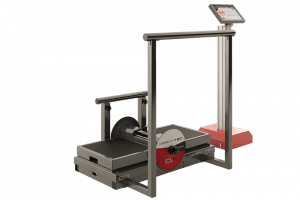
Desmotec D.FULL
ABSTRACT
The present study investigated the effects of in-season enhanced negative work-based training (ENT) vs weight training in the change of direction (COD), sprinting and jumping ability, muscle mass and strength in semi-professional soccer players.
Forty male soccer players participated in the eight-week, 1 d/w intervention consisting of 48 squat repetitions for ENT using a flywheel device (inertia=0.11 kg·m-2) or weight training (80%1 RM) as a control group (CON). Agility T-test, 20+20 m shuttle, 10 m and 30 m sprint, squat jump (SJ) and countermovement jump (CMJ), lean mass, quadriceps and hamstrings strength and the hamstrings-to-quadriceps ratio were measured. Time on agility T-test and 20+20 m shuttle decreased in ENT (effect-size =-1.44, 95% CI -2.24/-0.68 and -0.75, -1.09/-0.42 respectively) but not in CON (-0.33, -0.87/0.19 and -0.13, -0.58/0.32). SJ and CMJ height increased in both ENT (0.71, 0.45/0.97 and 0.65, 0.38/0.93) and CON (0.41, 0.23/0.60 and 0.36, 0.12/0.70). Overall, quadriceps and hamstrings strength increased in both ENT and CON (0.38/0.79), but the hamstrings-to-quadriceps ratio increased in ENT (0.31, 0.22/0.40) but not in CON (0.03, -0.18/0.24). Lean mass increased in both ENT (0.41, 0.26/0.57) and CON (0.29, 0.14/0.44). The repeated negative actions performed in ENT may have led to improvements in braking ability, a key point in COD performance. Semi-professional soccer players may benefit from in-season ENT to enhance COD and the negative-specific adaptations in muscle strength and hamstrings-to-quadriceps ratio.
Click here to access the whole feature.
Влияние постактивационной потенциации после эксцентрической перегрузки на прыжок с противодвижением и силу мышц нижних конечностей.
Scientific feature that shows the results of Eccentric training evaluated through Specific tests.
It was published by Prof. Marco Beato, Desmotec Academy Member and Senior Lecturer in Strength & Conditioning at University of Suffolk, on the Journal of Strength and Conditioning Research, January 2019.
The aim of this project is to evaluate the postactivation potentiation (PAP) effects of an eccentric overload (EOL) exercise on countermovement jump (CMJ) performance and isokinetic lower-limb muscle strength. The Desmotec device D.Full was also used in the research process.
Desmotec D.FULL
ABSTRACT
Beato, M, Stiff, A, and Coratella, G. Effects of postactivation potentiation after an eccentric overload bout on countermove- ment jump and lower-limb muscle strength. J Strength Cond Res XX(X): 000–000, 2018—This study aimed to evaluate the postactivation potentiation (PAP) effects of an eccentric over- load (EOL) exercise on countermovement jump (CMJ) perfor- mance and isokinetic lower-limb muscle strength.
Eighteen active men (mean 6 SD, age 20.2 6 1.4 years, body mass 71.6 6 8 kg, and height 178 6 7 cm) were involved in a randomized, crossover study. The participants performed 3 sets per 6 repetitions of EOL half squats at maximal power using a flywheel ergometer. Postactivation potentiation using an EOL exercise was compared with a control condition (10-minute cycling at 1 W$kg21). Countermovement jump height, peak power, impulse, and force were recorded at 15 seconds, 1, 3, 5, 7, and 9 minutes after an EOL exercise or control. Furthermore, quadriceps and hamstrings isokinetic strength were performed.
Postactivation potentiation vs. control reported a meaningful difference for CMJ height after 3 minutes (effect size [ES] = 0.68, p = 0.002), 5 minutes (ES = 0.58, p = 0.008), 7 minutes (ES = 0.57, p = 0.022), and 9 minutes (ES = 0.61, p = 0.002), peak power after 1 minute (ES = 0.22, p = 0.040), 3 minutes (ES = 0.44, p = 0.009), 5 minutes (ES = 0.40, p = 0.002), 7 minutes (ES = 0.29, p = 0.011), and 9 minutes (ES = 0.30, p = 0.008), as well as quadriceps concentric, hamstrings concentric, and hamstrings eccentric peak torque (ES = 0.13, p = 0.001, ES = 0.24, p = 0.003, and ES = 0.22, p = 003, respectively) after 3–9 minutes of rest.
In conclusion, the present outcomes highlight that PAP using an EOL bout improves height, peak power, impulse, and peak force during CMJ, as well as quadriceps and hamstrings
isokinetic strength in male athletes. Moreover, the optimal time window for the PAP was found from 3 to 9 minutes.
Click here to read the whole feature.
Мышечные и системные молекулярные реакции на изоинерционную тренировку на DESMOTEC у мужчин, тренирующихся с отягощениями.
Scientific feature that focuses on the muscle and systemic molecular responses obtained after a single flywheel based training session and evaluated through Specific tests.
It was published by Dr. GIosué Annibalini and a team of researchers of the University of Urbino Carlo Bo, on Frontiers in Physiology, May 2019
The aim of this project is to evaluate the molecular adaptations induced by Flywheel exercises. The Desmotec device D.Sport was also used in the research process.
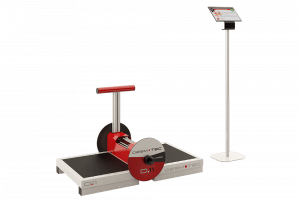
Desmotec D.SPORT
ABSTRACT
Growing evidence points to the effectiveness of flywheel (FW) based iso-inertial resistance training in improving physical performance capacities. However, molecular adaptations induced by FW exercises are largely unknown. Eight resistance-trained men performed 5 sets of 10 maximal squats on a FW device. Muscle biopsies (fine needle aspiration technique) and blood samples were collected before (t0), and 2 h (t1) after FW exercise. Blood samples were additionally drawn after 24 h (t2) and 48 h (t3).
Paired samples t-tests revealed significant increases, at t1, of mRNA expression of the genes involved in inflammation, in both muscle (MCP-1, TNF-α, IL-6) and peripheral blood mononuclear cells (IkB-α, MCP-1). Circulating extracellular vesicles (EVs) and EV-encapsulated miRNA levels (miR-206, miR-146a) significantly increased at t1 as well. Conversely, muscle mRNA level of genes associated with muscle growth/remodeling (IGF-1Ea, cyclin D1, myogenin) decreased at t1. One-way repeated measure ANOVAs, with Bonferroni corrected post-hoc pairwise comparisons, revealed significant increases in plasma concentrations of IL-6 (t1; t2; t3) and muscle creatine kinase (t1; t2), while IGF-1 significantly increased at t2 only. Our findings show that, even in experienced resistance trained individuals, a single FW training session modifies local and systemic markers involved in late structural remodeling and functional adaptation of skeletal muscle.
Click here to read the whole feature.

